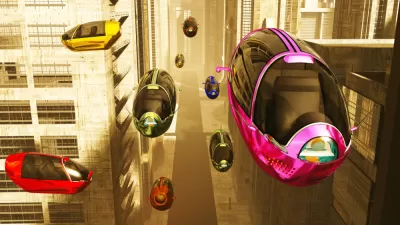A journalist asked, so Jarrett Walker answered.

Jarrett Walker, of Human Transit fame, has seen the recent buzz surrounding flying cars, flying taxis, passenger drones, and Uber Air. A journalist that goes unnamed asked for Walker's opinion on the subject. Here's what Walker had to say:
For every technology pitch, you must ask not just “what is this like from the inside?” but also “what is it like from the outside?” All vehicle technologies are sold based on how cool or useful it will be to ride them. And most of these pitches do not want you think about what it will be like to be outside of them, or to share a city with them.
The issues with flying taxis, cars, passenger drones, and on-demand helicopter services are obvious, according to Walker:
Even if they are much quieter than helicopters, they will introduce a new type level of noise to the city, anywhere near where they takeoff and land. Their presence overhead in any numbers will have physical and emotional effects on the population. They will introduce entirely new kinds of accidents that make everyone fearful of the space above them. And in the end, by allowing elites to opt out of the transportation problems that everybody else in the city is having, they will encourage elite disinterest in solving those problems.
Walker isn't the first to communicate skepticism about the new wave of transportation futurism. Matt Caywood, CEO of TransitScreen, wrote an op-ed over the summer that said cities would be better off planning for and investing in public transit than fancy airborne solutions to the problems of urban congestion.
FULL STORY: On Flying Cars

Planetizen Federal Action Tracker
A weekly monitor of how Trump’s orders and actions are impacting planners and planning in America.

Maui's Vacation Rental Debate Turns Ugly
Verbal attacks, misinformation campaigns and fistfights plague a high-stakes debate to convert thousands of vacation rentals into long-term housing.

San Francisco Suspends Traffic Calming Amidst Record Deaths
Citing “a challenging fiscal landscape,” the city will cease the program on the heels of 42 traffic deaths, including 24 pedestrians.

Defunct Pittsburgh Power Plant to Become Residential Tower
A decommissioned steam heat plant will be redeveloped into almost 100 affordable housing units.

Trump Prompts Restructuring of Transportation Research Board in “Unprecedented Overreach”
The TRB has eliminated more than half of its committees including those focused on climate, equity, and cities.

Amtrak Rolls Out New Orleans to Alabama “Mardi Gras” Train
The new service will operate morning and evening departures between Mobile and New Orleans.
Urban Design for Planners 1: Software Tools
This six-course series explores essential urban design concepts using open source software and equips planners with the tools they need to participate fully in the urban design process.
Planning for Universal Design
Learn the tools for implementing Universal Design in planning regulations.
Heyer Gruel & Associates PA
JM Goldson LLC
Custer County Colorado
City of Camden Redevelopment Agency
City of Astoria
Transportation Research & Education Center (TREC) at Portland State University
Jefferson Parish Government
Camden Redevelopment Agency
City of Claremont




























